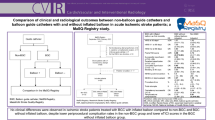Abstract
Introduction
Endovascular treatment of ruptured wide-neck bifurcation aneurysms presents a challenge. While still under evaluation, the Woven Endobridge (WEB) aneurysm embolization system has so far shown promising results in the treatment of complex bifurcation aneurysms. We aimed to evaluate the feasibility and short-term follow-up of endovascular treatment of ruptured wide-neck aneurysm with the WEB device.
Methods
Six patients referred to our institution for acute symptomatic subarachnoid hemorrhage (SAH) and treated with the WEB device were enrolled in this study. Clinical presentations, technical details, intraoperative and postoperative complications, and outcomes were recorded. Immediate and 3-month angiographic results were also evaluated.
Results
Three middle cerebral artery (MCA) and three anterior communicating artery aneurysms were treated between 1 and 14 days after rupturing. Average dome width was 5.8 mm (range 5–7), average neck size was 4.5 mm (range 4–5), and average dome-to-neck ratio was 1.3 (range 1–1.7). The WEB system was the exclusive treatment and was successfully deployed in all cases. Per procedural thromboembolic events occurred in two cases and were treated with intra-arterial administration of antiplatelet agents without any clinical consequences. The modified Rankin Scale (mRS) score at discharge was 0 for all patients. The 3-month angiographic follow-up showed adequate occlusion in four of our six patients (67 %).
Conclusion
From this preliminary study, the high feasibility rate and lack of need for systematic antiplatelet agents favor the WEB device providing a solution for endovascular treatment of ruptured wide-neck bifurcation aneurysms during the acute phase. However, further studies are needed to evaluate the complication rate and long-term efficiency.





Similar content being viewed by others
Abbreviations
- EVT:
-
Endovascular treatment
- WEB:
-
Woven Endobridge
- SAH:
-
Subarachnoid hemorrhage
- MCA:
-
Middle cerebral artery
- mRS:
-
Modified Rankin Scale
References
Molyneux AJ, Kerr RSC, Yu L-M et al (2005) International subarachnoid aneurysm trial (ISAT) of neurosurgical clipping versus endovascular coiling in 2143 patients with ruptured intracranial aneurysms: a randomised comparison of effects on survival, dependency, seizures, rebleeding, subgroups, and aneurysm occlusion. Lancet 366:809–817
Cognard C, Pierot L, Anxionnat R et al (2011) Results of embolization used as the first treatment choice in a consecutive nonselected population of ruptured aneurysms: clinical results of the Clarity GDC Study. Neurosurgery 69:837–842
Moret J, Cognard C, Weill A et al (1997) Reconstruction technic in the treatment of wide-neck intracranial aneurysms. Long-term angiographic and clinical results.Apropos of 56 cases. J Neuroradiol J Neuroradiol 24:30–44
Pierot L, Cognard C, Spelle L et al (2012) Safety and efficacy of balloon remodeling technique during endovascular treatment of intracranial aneurysms: critical review of the literature. AJNR Am J Neuroradiol 33:12–15
Shapiro M, Babb J, Becske T et al (2008) Safety and efficacy of adjunctive balloon remodeling during endovascular treatment of intracranial aneurysms: a literature review. AJNR Am J Neuroradiol 29:1777–1781
Rodríguez-Hernández A, Sughrue ME, Akhavan S et al (2013) Current management of middle cerebral artery aneurysms: surgical results with a "clip first" policy. Neurosurgery 72:415–427
Gaughen JR, Hasan D, Dumont AS et al (2010) The efficacy of endovascular stenting in the treatment of supraclinoid internal carotid artery blister aneurysms using a stent-in-stent technique.AJNR. Am J Neuroradiol 31:1132–1138
De Barros FM, Castro RN, Lundquist J et al (2011) The role of the pipeline embolization device for the treatment of dissecting intracranial aneurysms. Am J Neuroradiol 32:2192–2195
Consoli A, Nappini S, Renieri L et al (2012) Treatment of two blood blister-like aneurysms with flow diverter stenting. J Neurointerventional Surgery 4:e4
Meckel S, Singh TP, Undrén P et al (2011) Endovascular treatment using predominantly stent-assisted coil embolization and antiplatelet and anticoagulation management of ruptured blood blister-like aneurysms. AJNR Am J Neuroradiol 32:764–771
Ding YH, Lewis DA, Kadirvel R et al (2011) The Woven EndoBridge: a new aneurysm occlusion device. AJNR Am J Neuroradiol 32:607–611
Klisch J, Sychra V, Strasilla C et al (2011) The Woven EndoBridge cerebral aneurysm embolization device (WEB II): initial clinical experience. Neuroradiology 53:599–607
Pierot L, Liebig T, Sychra V et al (2012) Intrasaccular flow-disruption treatment of intracranial aneurysms: preliminary results of a multicenter clinical study. AJNR Am J Neuroradiol 33:1232–1238
Pierot L, Klisch J, Cognard C et al (2013) Endovascular WEB Flow disruption in middle cerebral artery aneurysms: preliminary feasibility, clinical, and anatomical results in a multicenter study. Neurosurgery 73:27–35
Lubicz B, Mine B, Collignon L et al (2013) WEB device for endovascular treatment of wide-neck bifurcation aneurysms. AJNR Am J Neuroradiol 34:1209–1214
Caroff J, Mihalea C, Neki H, et al 2014 Role of C-Arm VasoCT in the use of endovascular WEB flow disruption in intracranial aneurysm treatment. AJNR American journal of neuroradiology
Raymond J, Guilbert F, Weill A et al (2003) Long-term angiographic recurrences after selective endovascular treatment of aneurysms with detachable coils. Stroke; J Cerebral Circulation 34:1398–1403
Pierot L, Cognard C, Anxionnat R et al (2010) Ruptured intracranial aneurysms: factors affecting the rate and outcome of endovascular treatment complications in a series of 782 patients (CLARITY study). Radiology 256:916–923
McDonald JS, McDonald RJ, Fan J et al (2014) Comparative effectiveness of ruptured cerebral aneurysm therapies: propensity score analysis of clipping versus coiling. AJNR Am J Neuroradiol 35:164–169
Lubicz B, Klisch J, Gauvrit J-Y, et al 2014 WEB-DL Endovascular treatment of wide-neck bifurcation aneurysms: short- and midterm results in a european study. AJNR American journal of neuroradiology
Ethical standards and patient consent
We declare that all human studies have been approved by the AP-HP Ethical Committee and have therefore been performed in accordance with the ethical standards laid down in the 1964 Declaration of Helsinki and its later amendments. We declare that all patients gave informed consent prior to inclusion in this study.
Conflict of interest
LS and JM consult for Sequent Medical.
Author information
Authors and Affiliations
Corresponding author
Rights and permissions
About this article
Cite this article
Caroff, J., Mihalea, C., Dargento, F. et al. Woven Endobridge (WEB) Device for endovascular treatment of ruptured intracranial wide-neck aneurysms: a single-center experience. Neuroradiology 56, 755–761 (2014). https://doi.org/10.1007/s00234-014-1390-7
Received:
Accepted:
Published:
Issue Date:
DOI: https://doi.org/10.1007/s00234-014-1390-7




